It is easy to see how entire armies perished on the road to Khiva. By land the city is reached after an 8 hour journey from Bukhara, along one of the most desolate and inhospitable highways in the world. Temperatures frequently top 45C in the shade, and even stepping out of our vehicle for a few moments en route was enough to experience the wall of heat that came up from the sand to meet any exposed skin. An hour here without shade or water could be fatal. (It’s hard to believe that winter temperatures in the same spot drop below -35C!)
Having read the Great Game by Peter Hopkirk, I was excited to be visiting this city, so long at the epicenter of the phony war between 19th century Russia and the Victorian British Empire. For many years before that Khiva was a key staging post along the Silk Route, where the rulers revelled in the opulence afforded by the hefty taxes imposed on those passing through. The Khanate of Khiva, as it was known then, was controlled by the Khan through fear and often brutal violence. The Russians attempted to gain control of the city on three occasions. They fell first to a simple deception that allowed the vastly outnumbered Khan to butcher the entire invading army. Then a larger army almost entirely perished in the desert before they even reached the walled city, such were the brutal conditions that they faced. Only in 1873 did they finally manage to gain control of the city and bring it under Russian influence.
Now heavily restored, the Itchan Kala, or Inner City of Khiva, is like a museum city. The environment here destroys the fabric of buildings in a short period of time, which means that renovation is essential if these treasures are not to be submerged into the surrounding desert. Wandering through the maze of alleys and admiring the rooftops from the various vantage points, it is amazing to consider that less than a century ago the Emir still ruled this city, albeit under Russian influence. The buildings are of astounding beauty and intricacy, with majolica tiles bringing both colour and contrast to the sandy structures around. The shade is welcome in the scorching midday sun, and is readily found in the mosques, madrassahs and the many cafes that litter the city.
We visited during the Independence Holiday at the end of August, and it was a pleasure to see many Uzbek tourists also visiting the site.
Khiva is remote, and requires an effort to reach. If approaching by land from any direction, you will see how fragile life would have been here, the dependence on the Oxus (Amu Darya) river for sustenance, and the way in which the city’s isolation allowed rulers to impose their will with absolute impunity for so many years.
 Henry Moore at Hatfield: a Philistine's review
Henry Moore at Hatfield: a Philistine's review The ABC guide to trekking in Nepal – part 1
The ABC guide to trekking in Nepal – part 1